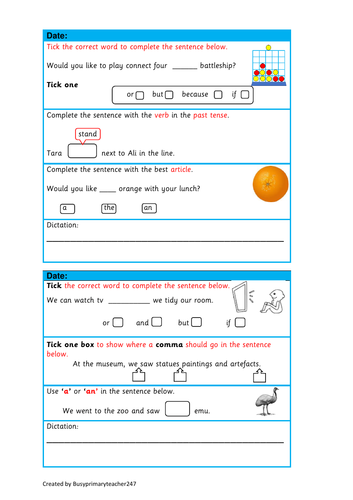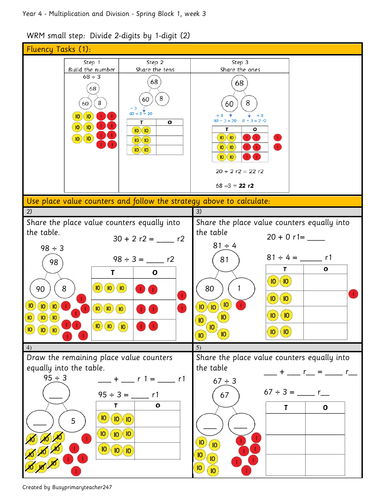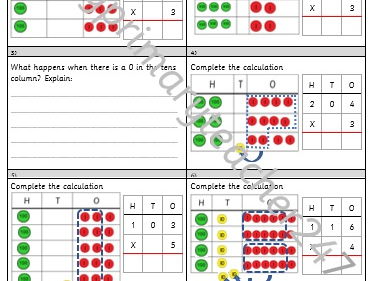132Uploads
175k+Views
66k+Downloads
All resources

Year 2 - Spring Term - week 1 - Multiplication and Division
This resource covers the first 3 small steps for year 2, Spring, week 1 Multiplication, and Division.
This pack contains a series of differentiated worksheets (and answers) that follow the concrete, pictorial and abstract method for maths mastery. They also include reasoning and problem-solving.
Curriculum links:
- Recall and use multiplication and division facts for the 2, 5 and 10 times tables, including recognising odd and even numbers.
- Calculate mathematical statements for multiplication and division within the multiplication tables and write them using the multiplication (×), division (÷) and equals (=) signs.
- Solve problems involving multiplication and division, using materials, arrays, repeated addition, mental methods and multiplication and division facts, including problems in contexts.
- Show that the multiplication of two numbers can be done in any order (commutative) and division of one number by another cannot.
I hope these are helpful!!
Your feedback is always welcome x
Most images created by Busyprimaryteacher247
All other images sourced from: https://wpclipart.com/index.html

Year 3 question strips - Multiplication and Division - Spring block 1 (2)
Question strips to complement varied fluency and reasoning for Year 3 Spring block 1 - Multiplication and Division.
Small step -Related calculations
Curriculum links:
- Recall and use multiplication and division facts for the 3, 4 and 8 multiplication tables.
-Write and calculate mathematical statements for multiplication and division using the multiplication tables they know, including for two-digit
numbers times one-digit numbers, using mental and progressing to formal written methods.
I hope this resource is helpful!
Your feedback is always welcome x

Question strips to go with year 3, Spring block 1 - Multiplication and division (1)
Question strips to complement varied fluency and reasoning for Year 3 Spring block 1 - Multiplication and Division.
Small step -Comparing statements
Curriculum links:
- Recall and use multiplication and division facts for the 3, 4 and 8 multiplication tables.
-Write and calculate mathematical statements for multiplication and division using the multiplication tables they know, including for two-digit
numbers times one-digit numbers, using mental and progressing to formal written methods.
I hope this resource is helpful!
Your feedback is always welcome x

Question strips for year 3 - multiplication and division - Spring bock 1 (3)
Question strips to complement varied fluency and reasoning for Year 3 Spring block 1 - Multiplication and Division.
Small step -Multiply 2-digits by 1-digit (1)
Curriculum links:
- Recall and use multiplication and division facts for the 3, 4 and 8 multiplication tables.
-Write and calculate mathematical statements for multiplication and division using the multiplication tables they know, including for two-digit
numbers times one-digit numbers, using mental and progressing to formal written methods.
-Solve problems, including missing number problems, involving multiplication and division, including positive integer scaling problems
and correspondence problems in which n objects are connected to m
objectives.
I hope this resource is helpful!
Your feedback is always welcome x

Year 3 - differentiated worksheets - Mass
Here are 2 differentiated worksheets based on the weight of objects. It includes addition, subtraction, multiplication (integer scaling) and reasoning questions.
Curriculum links:
-Measure, compare, add and subtract: mass (g/kg)
-Compare the mass of objects using mixed units (g/kg)
-Compare the weight of objects using simple scaling by integers.
I hope you find this resource useful.
Your feedback is always welcome x
Bundle

Year 3 Measurement bundle
Here are differentiated worksheets based on the length, mass and capacity of objects. They each contain addition, subtraction, multiplication (integer scaling) and reasoning questions.
Curriculum links:
-Measure, compare, add and subtract: length, mass, capacity
-Compare the length, mass, capacuty of objects using mixed units
-Compare the length, mass, capacity of objects using simple scaling by integers.
I hope you find this resource useful.
Your feedback is always welcome x

5 SPaG question strips for years 3 and 4 (set 1)
This resource contains 5 question strips linked to the year 3 and 4 SPaG curriculum.
Curriculum links:
- Write from memory simple sentences dictated by the teacher, that include words and punctuation taught so far.
- Spell further homophones.
- Spell words that are often misspelt (year 3 /4 common exception words).
- Use further prefixes and understand how to add them
- Use further suffixes and understand how to add them
- Use the correct form of ‘a’ or ‘an’
- Use inverted commas to punctuate direct speech
- Place the possessive apostrophe accurately in words with regular plurals e.g. girls’, boys’ and in words with irregular plurals e.g. children’s.
I hope you find this useful.
Your feedback is always welcome x
Images sourced from https://wpclipart.com/index.html

Year 3 - differentiated worksheets - Capacity
Here are 2 differentiated worksheets based on the capacity of objects. It includes addition, subtraction, multiplication (integer scaling) and reasoning questions.
Curriculum links:
-Measure, compare, add and subtract: Capacity (ml/l)
-Compare the capacity of objects using mixed units (ml/l)
-Compare the capacity of objects using simple scaling by integers.
I hope you find this resource useful.
Your feedback is always welcome x

5 SPaG question strips - year 3 and 4 (set 4)
This resource contains 5 question strips linked to the year 3 and 4 SPaG curriculum.
Curriculum links:
- Write from memory simple sentences dictated by the teacher, that include words and punctuation taught so far.
- Spell further homophones.
- Spell words that are often misspelt (year 3 /4 common exception words).
- Use further prefixes and understand how to add them
- Use further suffixes and understand how to add them
- Use the correct form of ‘a’ or ‘an’
- Use inverted commas to punctuate direct speech
- Place the possessive apostrophe accurately in words with regular plurals e.g. girls’, boys’ and in words with irregular plurals e.g. children’s.
I hope you find this useful.
Your feedback is always welcome x
Images sourced from https://wpclipart.com/index.html

5 SPaG question strips - year 3 and 4 (set 3)
This resource contains 5 question strips linked to the year 3 and 4 SPaG curriculum.
Curriculum links:
- Write from memory simple sentences dictated by the teacher, that include words and punctuation taught so far.
- Spell further homophones.
- Spell words that are often misspelt (year 3 /4 common exception words).
- Use further prefixes and understand how to add them
- Use further suffixes and understand how to add them
- Use the correct form of ‘a’ or ‘an’
- Use inverted commas to punctuate direct speech
- Place the possessive apostrophe accurately in words with regular plurals e.g. girls’, boys’ and in words with irregular plurals e.g. children’s.
I hope you find this useful.
Your feedback is always welcome x
Images sourced from https://wpclipart.com/index.html

5 SPaG question strips with dictation sentence - year 3 and 4 (set 2)
This resource contains 5 question strips linked to the year 3 and 4 SPaG curriculum.
Curriculum links:
- Write from memory simple sentences dictated by the teacher, that include words and punctuation taught so far.
- Spell further homophones.
- Spell words that are often misspelt (year 3 /4 common exception words).
- Use further prefixes and understand how to add them
- Use further suffixes and understand how to add them
- Use the correct form of ‘a’ or ‘an’
- Use inverted commas to punctuate direct speech
- Place the possessive apostrophe accurately in words with regular plurals e.g. girls’, boys’ and in words with irregular plurals e.g. children’s.
I hope you find this useful.
Your feedback is always welcome x
Images sourced from https://wpclipart.com/index.html
Bundle

20 SPaG question strips linked to year 3 and 4 curriculum
This resource contains 20 question strips linked to the year 3 and 4 SPaG curriculum.
A list of 20 simple sentences for dictation is also included.
Curriculum links:
- Write from memory simple sentences dictated by the teacher, that include words and punctuation taught so far.
- Spell further homophones.
- Spell words that are often misspelt (year 3 /4 common exception words).
- Use further prefixes and understand how to add them
- Use further suffixes and understand how to add them
- Use the correct form of ‘a’ or ‘an’
- Use inverted commas to punctuate direct speech
- Place the possessive apostrophe accurately in words with regular plurals e.g. girls’, boys’ and in words with irregular plurals e.g. children’s.
I hope you find this useful.
Your feedback is always welcome x
Images sourced from https://wpclipart.com/index.html

Year 2 - Quiz Quiz Trade activity linked to identifying 2-digit numbers in a variety of representati
This is a year 2 Cooperative Learning activity linked to identifying 2-digit numbers through a variety of representations (up to 99).
Hardly any prep required- just print off, cut out and stick together.
Instructions are on the last page.
I hope your class enjoys this activity as much as mine did!
Your feedback is always welcome x

20 simple sentences to be dictated to pupils by the teacher - years 3 and 4
This resource contains 20 simple sentences that can be dictated to pupils
( Write from memory simple sentences dictated by the teacher, that include words and punctuation taught so far.)
I have included words from the common exception list as well as some other SPaG items from the year 3 and 4 curriculum.
Curriculum links:
- Write from memory simple sentences dictated by the teacher, that include words and punctuation taught so far.
- Spell further homophones.
- Spell words that are often misspelt (year 3 /4 common exception words).
- Use further prefixes and understand how to add them
- Use further suffixes and understand how to add them
- Use the correct form of ‘a’ or ‘an’
- Use inverted commas to punctuate direct speech
- Place the possessive apostrophe accurately in words with regular plurals e.g. girls’, boys’ and in words with irregular plurals e.g. children’s.
I hope you find this useful.
Your feedback is always welcome x

Year 2 - Spring Block 1 - week 2 - Multiplication and Division
This resource covers the final 3 small steps for year 2, Spring block 1, week 2 Multiplication, and Division.
This pack contains a series of differentiated worksheets (and answers) that follow the concrete, pictorial and abstract method for maths mastery. They also include reasoning and problem-solving.
Small Steps:
-Odd and even numbers
- Divide by 5
-Divide by 10
Curriculum links:
- Recall and use multiplication and division facts for the 2, 5 and 10 times tables, including recognising odd and even numbers.
- Calculate mathematical statements for multiplication and division within the multiplication tables and write them using the multiplication (×), division (÷) and equals (=) signs.
- Solve problems involving multiplication and division, using materials, arrays, repeated addition, mental methods and multiplication and division facts, including problems in contexts.
- Show that the multiplication of two numbers can be done in any order (commutative) and division of one number by another cannot.
I hope these are helpful!!
Your feedback is always welcome x
Most images created by Busyprimaryteacher247
All other images sourced from: https://wpclipart.com/index.html

Year 4 - Spring block 1 - Divide 2-digits by 1-digit (2) week 3
This resource links to Year 4, Spring, block 1(week 3) small step 'Divide 2-digits by 1-digit (2)'
The contents include differentiated worksheets (and answers) that follow the concrete, pictorial and abstract method for maths mastery. They also include reasoning and problem-solving.
Curriculum links:
- Recall and use multiplication and division facts for multiplication tables up to 12 ×12.
- Use place value, known and derived facts to multiply and divide mentally, including multiplying by 0 and 1; dividing by 1; multiplying together three numbers.
- Recognise and use factor pairs and commutativity in mental calculations.
-Solve problems involving multiplying and adding, including using the distributive law to multiply two digit numbers by one digit, integer scaling
problems and harder correspondence problems such as n objects are connected to m objects.
I hope you find these useful,
Your feedback is always welcome x

Year 4 - Multiply 3-digits by 1-digit
This resource links to Year 4, Spring, block 1 Multiplication, and Division and small step 'Multiply 3-digit by 1-digit numbers'.
The contents include differentiated worksheets (and answers) that follow the concrete, pictorial and abstract method for maths mastery. They also include reasoning and problem-solving.
Curriculum links:
- Recall and use multiplication and division facts for multiplication tables up to 12 ×12.
- Use place value, known and derived facts to multiply and divide mentally, including: multiplying by 0 and 1; dividing by 1; multiplying together three numbers.
- Recognise and use factor pairs and commutativity in mental calculations.
I hope you find these useful,
Your feedback is always welcome x

Year 4 - Divide 2-digits by 1-digit numbers
This resource links to Year 4, Spring, block 1(week 3) Multiplication, and Division and small step 'Divide 2-digits by 1-digit numbers'
The contents include differentiated worksheets (and answers) that follow the concrete, pictorial and abstract method for maths mastery. They also include reasoning and problem-solving.
Curriculum links:
- Recall and use multiplication and division facts for multiplication tables up to 12 ×12.
- Use place value, known and derived facts to multiply and divide mentally, including multiplying by 0 and 1; dividing by 1; multiplying together three numbers.
- Recognise and use factor pairs and commutativity in mental calculations.
-Solve problems involving multiplying and adding, including using the distributive law to multiply two digit numbers by one digit, integer scaling
problems and harder correspondence problems such as n objects are connected to m objects.
I hope you find these useful,
Your feedback is always welcome x
Bundle

Year 4 - Spring Block 1 - Week 3 resources
This bundles contains a series of differentiated worksheets (and answers) that follow the concrete, pictorial and abstract method for maths mastery. They also include reasoning and problem-solving tasks.
All worksheets link to the last 4 small steps for year 4, Spring, block 1 Multiplication, and Division.
WRM Small Steps:
- Multiply 3-digits by 1-digit
- Divide 2-digits by 1-digit (1)
- Divide 2-digits by 1-digit (2)
- Correspondence problems
Curriculum links:
- Recall and use multiplication and division facts for multiplication tables up to 12 ×12.
- Use place value, known and derived facts to multiply and divide mentally, including: multiplying by 0 and 1; dividing by 1; multiplying together three numbers.
- Recognise and use factor pairs and commutativity in mental calculations.
-Solve problems involving multiplying
and adding, including using the
distributive law to multiply two digit
numbers by one digit, integer scaling
problems and harder correspondence problems such as n objects are connected to m objects.
Australian Curriculum links:
-Represent and solve problems involving multiplication using efficient mental and written strategies and appropriate digital technologies (ACMNA057)
-Recall multiplication facts of two, three, five and ten and related division facts (ACMNA056)
Achievement Standards:
- Understanding includes connecting names, numerals, and quantities.
- Fluency includes readily counting numbers in sequences, continuing patterns and comparing the lengths of objects.
- Problem-solving includes using materials to model authentic problems, sorting objects, using familiar counting sequences to solve unfamiliar problems and discussing the reasonableness of the answer.
- Reasoning includes explaining comparisons of quantities, creating patterns and explaining processes for indirect comparison of length.
I hope you find these useful,
Your feedback is always welcome x

Year 4 multiplication (C-P-A)- Australian Curriculum linked
These resources follow the Math mastery approach of using concrete-pictorial-abstract models. They are differentiated and the answer sheets are included (you're welcome).
Links to the new Australian Curriculum - Year 4 -
-Apply place value to partition, rearrange and regroup numbers to at least tens of thousands to assist calculations and solve problems (ACMNA073)
- Investigate number sequences involving multiples of 3, 4, 6, 7, 8, and 9 (ACMNA074)
-Recall multiplication facts up to 10 × 10 and related division facts (ACMNA075)
- Develop efficient mental and written strategies and use appropriate digital technologies for multiplication and for division where there is no remainder (ACMNA076)




















